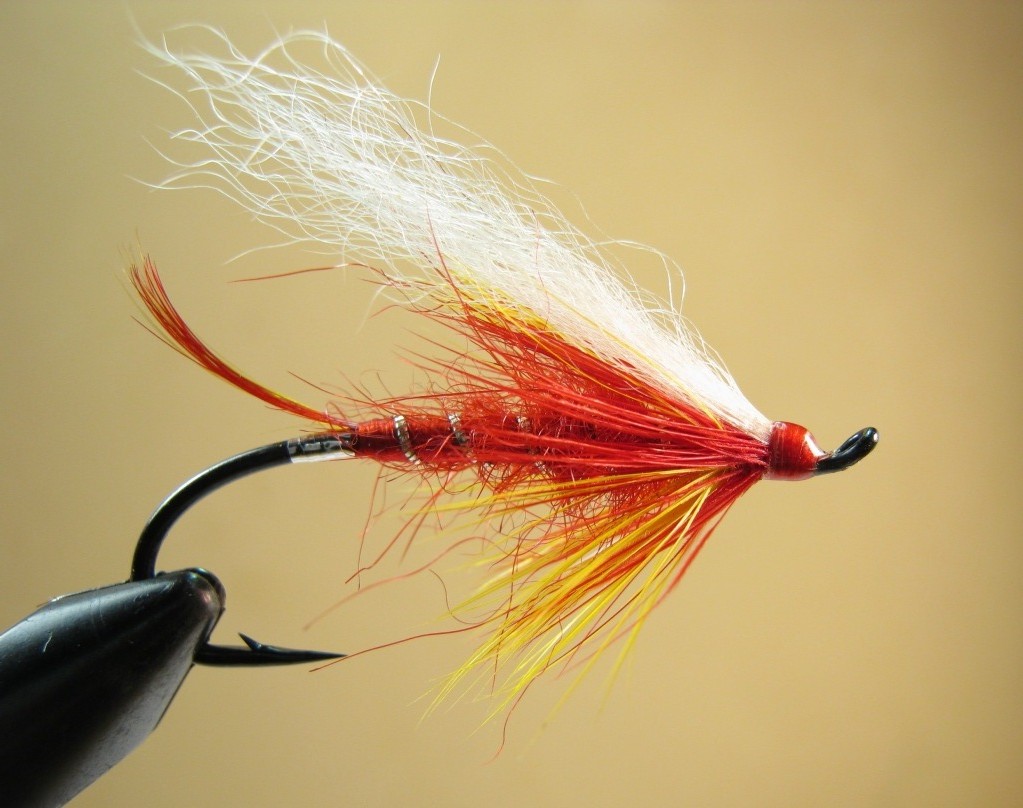
On The Fly
December 2011
"Fly tying is a school from which we never graduate"
TYING NEWS
The Southern Oregon Fly Tyers invite you to attend their meetings the second Tuesday of
each month. The next meeting is December 13, 2011. The meetings start at 6:00 PM, at the Madrone Hill
Mobile Home Park community building near Gold Hill. Bring a friend, come early so you don't miss
anything, and stay late. Tyers need not be experienced, and those with all levels of skill are
welcome. Each meeting a member is encouraged to demonstrate a new or different skill, from simple
to difficult. For more information, call Dan Kellogg at 773-4724.
DIRECTIONS: Take Gold Hill Exit #40, off of I-5 and go west, toward Jacksonville, 1.3 miles, until you
reach the brick entrance way to the Madrone Hill Mobile Home Park on the right. Youíll pass a golf course
parking lot on your left shortly after leaving the freeway. After you turn right into the
mobile home park, proceed to the community building which is located about 100 yards ahead on the left. The
address is 8401 Old Stage Rd. Please park your vehicle on the bare dirt in the parking lot to avoid the
wooden septic covers in the grass
 PATTERN OF THE MONTH -Skykomish Sunrise
PATTERN OF THE MONTH -Skykomish Sunrise
Hook: Daiichi 2441, Salmon/Steelhead, 4-8.
Thread: 6-0 red.
Tag: Flat silver tinsel, small
Tail: Red over yellow, Golden Pheasant crest.
Rib: Oval silver tinsel, small.
Body: Red seal sub.
Hackle: Red over yellow saddle.
Wing: White kid goat.
Head: Tying thread.
Tying Instructions:
Step 1: Mash the barb and mount the hook in the vise.
Step 2: Start the thread one eye width behind the eye and lay down an even thread base to a position just
above the hook point.
Step 3: Tie in the flat tinsel at this point. Wind rearward 4 turns and then forward 4 turns. Tie off and
trim excess.
Step 4: Select a yellow crest feather, measure 2/3 body length, and tie on with the curve up at the front
end of the tag. Repeat the process with the red color. Trim the excess at the front end of the body area
and tie down on top of the shank with spiral wraps forward and back.
Step 5: Tie in a length of oval tinsel at the base of the tail and leave hang to the rear for the rib later.
Step 6: Form a dubbing loop at the base of the tail, advance the thread to the front of the body, insert
the red seal sub sparsely into the loop, twist the loop into a rope, and wind the dubbing rope forward to
the thread location. Tie off and trim.
Step 7: Wind the rib forward over the body with 5 evenly spaced spiral turns. Tie off and trim excess.
Step 8: Select a yellow hackle feather with barbs reaching almost to the hook point, tie in by the tip, and
wind forward 3 turns while stroking the barbs rearward on each half turn. Tie off and trim excess. Repeat
the process with the red hackle feather in front of the yellow.
Step 9: Select a small bunch of kid goat hair from the hide, do not stack, measure length from the end of
the tail, and tie on just in front of the hackle. Tie off with tight turns and trim the excess at an angle
toward the eye.
Step 10: Use a drop of super glue to secure the wing to the shank, then form a neat tapered head and cement.
The birth of the Skykomish Sunrise pattern goes back to 1938, though there are conflicting
accounts of it's history. It was created by father and son Steelheaders, Ken and George Mcleod of Seattle
for the winter runs, and tied as a gift for George's brother. Of course it was named for and inspired by
the beautiful sunrises on the Skykomish River in Western Washington State. In the 1950's McLeod himself set
a fly rod world record catching a 29 pound steelhead on the fly. Since then the Skykomish Sunrise has been
a staple for Steelheaders throughout the Northwest and into the Great Lakes area. This fly is tied with
traditional bright, flashy red and white materials in order to gain the fish's attention in the often cold,
murky flows of winter and spring. Originally tied with Polar Bear for the wing and a chenille body, the
version pictured above is a modern twist that I prefer.
The fly sinks quickly and a well-tied pattern will ride smooth and proper in rougher
currents. Fish it with a wet fly swing, casting up and across stream. For the fanatical winter steelhead
fly fisher a good day is 40 degrees and nasty. Thatís when thousand of these hearty and seemingly foolish
fish come up streams while most other fish in the region are doing nothing at all. There is not a more
crazed fisher than the winter steelhead fly fisher. Here's your fly.
Tying Tips
There are several material substitutions that will make this pattern doable for any tier.
Sub saddle hackle barbs for the tail and chenille for the body. Leave off the tag if you want and use calf,
fox, or buck tail for the wing. The result should be just as effective using common materials. Use a heavy
gauge wire hook and keep it somewhat sparse. You want it to sink down in front of that steely.
So tie some up, give them a test flight, and let me know how you do.
Tie One On,
Dan Kellogg
(you can contact me at FLYGUY@EZNORTHWEST.COM)
www.tyerstoolshop.com